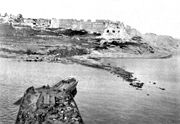
Sedd el Bahr
Encyclopedia

Cape Helles
Cape Helles is the rocky headland at the south-westernmost tip of the Gallipoli peninsula, Turkey. It was the scene of heavy fighting between Turkish and British troops during the landing at Cape Helles at the beginning of the Gallipoli Campaign in 1915....
on the Gallipoli
Gallipoli
The Gallipoli peninsula is located in Turkish Thrace , the European part of Turkey, with the Aegean Sea to the west and the Dardanelles straits to the east. Gallipoli derives its name from the Greek "Καλλίπολις" , meaning "Beautiful City"...
peninsula in Turkey
Turkey
Turkey , known officially as the Republic of Turkey , is a Eurasian country located in Western Asia and in East Thrace in Southeastern Europe...
. The village lies east of the cape, on the shore of the Dardanelles
Dardanelles
The Dardanelles , formerly known as the Hellespont, is a narrow strait in northwestern Turkey connecting the Aegean Sea to the Sea of Marmara. It is one of the Turkish Straits, along with its counterpart the Bosphorus. It is located at approximately...
. It was the site of V Beach, the landing zone for two Irish
Ireland
Ireland is an island to the northwest of continental Europe. It is the third-largest island in Europe and the twentieth-largest island on Earth...
battalion
Battalion
A battalion is a military unit of around 300–1,200 soldiers usually consisting of between two and seven companies and typically commanded by either a Lieutenant Colonel or a Colonel...
s, including one from the SS River Clyde
SS River Clyde
The SS River Clyde was a 4,000 ton collier built in Glasgow in 1905 and named after the River Clyde in Scotland. On April 25, 1915, the River Clyde was used as a Trojan horse for the landing at Cape Helles during the Battle of Gallipoli...
, on 25 April 1915 during the Battle of Gallipoli
Battle of Gallipoli
The Gallipoli Campaign, also known as the Dardanelles Campaign or the Battle of Gallipoli, took place at the peninsula of Gallipoli in the Ottoman Empire between 25 April 1915 and 9 January 1916, during the First World War...
.
At the tip of the Sedd el Bahr promontory is the castle, Sedd el Bahr Kale, also known as Eski Kale ("Old Castle") which was built in 1659. The British designated the castle "Fort No. 3" (at the other end of V Beach was "Fort No. 1", also known as Fort Ertugrul) and it was equipped with 10 artillery
Artillery
Originally applied to any group of infantry primarily armed with projectile weapons, artillery has over time become limited in meaning to refer only to those engines of war that operate by projection of munitions far beyond the range of effect of personal weapons...
pieces, including two 28 cm Krupp
Krupp
The Krupp family , a prominent 400-year-old German dynasty from Essen, have become famous for their steel production and for their manufacture of ammunition and armaments. The family business, known as Friedrich Krupp AG Hoesch-Krupp, was the largest company in Europe at the beginning of the 20th...
L/22 guns. The castle was bombarded by the Royal Navy
Royal Navy
The Royal Navy is the naval warfare service branch of the British Armed Forces. Founded in the 16th century, it is the oldest service branch and is known as the Senior Service...
on 3 November 1914 causing serious damage and killing 86 Turkish soldiers.
The British attacked the Turkish forts on 19 February 1915 at the start of the naval operations in the Dardanelles Campaign
Naval operations in the Dardanelles Campaign
The naval operations in the Dardanelles Campaign of the First World War were mainly carried out by the Royal Navy with substantial support from the French and minor contributions from Russia and Australia. The Dardanelles Campaign began as a purely naval operation...
. Sedd el Bahr was subjected to repeated bombardment and raids by naval demolition teams and the position was deemed too exposed. By the peak of naval operations on 18 March, Sedd el Bahr and Kum Kale, across the straits, had been eliminated as threats.
Sedd el Bahr is mentioned in the classic Irish song The Foggy Dew, second verse: "It was better to die 'neath an Irish sky than at Suvla
Suvla
Suvla is a bay on the Aegean coast of the Gallipoli peninsula in European Turkey, south of the Gulf of Saros.On 6 August 1915 it was the site for the Landing at Suvla Bay by the British IX Corps as part of the August Offensive during the Battle of Gallipoli...
or Sud el Bar."
See also
- Landing at Cape HellesLanding at Cape HellesThe landing at Cape Helles was part of the amphibious invasion of the Gallipoli peninsula by British and French forces on April 25, 1915 during the First World War. Helles, at the foot of the peninsula, was the main landing area. With the support of the guns of the Royal Navy, a British division...

